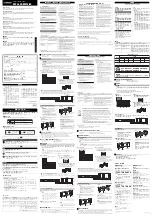
CPU Interface Functional Overview
Specific CPUs Aspects
Copyright © 2002 Marvell
CONFIDENTIAL
Doc. No. MV-S300165-00, Rev. A
May 21, 2002, Preliminary
Document Classification: Proprietary Information
Page 21
It is the designer's responsibility to ensure that the CPU is configured correctly to support the cache coherency.
For example, make sure that the W, I, M, G bits in the block attributes or page table entry indicate the correct set-
ting of the processor cache policy.
3.5
Specific CPUs Aspects
3.5.1 MPC745x Burst to Boot Address
The MPC745x instruction queue holds as many as 12 instructions and loads as many as four instructions per
cycle. After reset the MPC745x fetches instructions from the boot device (or any other cache-inhibited memory), in
60x-bus mode, the bus access is a 32 byte transaction (even though only the required 16 bytes are transmitted to
the instruction queue). In MPX bus mode, a cache-inhibited instruction fetch performs a 16 byte transaction on the
bus.
Since the MPC745x’s first transaction after boot is 32/16 byte read and the GT-64260A does not support burst
longer than 8 byte from 8-bits or 16-bits wide devices, implement one of the following solutions.
•
Use 32-bit wide boot device.
•
Use the Serial ROM Initialization at reset to copy 8-bit flash device to another 32-bit device (e.g. SRAM).
For example, the GT-64260A with the MPC745x evaluation platform (EV-64260ABP-MPC7450) uses an 8-bit wide
flash device and a 32-bits wide SRAM device to boot the CPU. Before the CPU reset de-assertion, the 8-bit flash
is copied to the 32-bits SRAM device by the I2C interface
Note
For more information on the serial ROM initialization, see the GT-64260A datasheet’s "Reset
Configuration" section.
System Initialization Sequence
The system initialization sequence is as follows:
1.
On the device bus, implement one 8-bit flash memory (used as the boot device connected to one of
the CS* signals) and a 32-bit wide SRAM on the boot chip select (BootCS*).
2.
Treat the 8-bit flash memory as the boot device. This means the boot image must be burned in the
flash memory.
3.
Burn an I
2
C EEPROM with a data sequence that initiates a DMA transfer from the 8-bit boot device
to the 32-bit SRAM. See
Appendix A. "I2C EEPROM Example" on page 147
4.
Configure the GT-64260A to serial ROM initialization enabled (AD[0] set to ’1’).
Note
When booting from an I
2
C EEPROM, the CPU must be kept at reset as long as the initialization process
takes place. This is accomplished by using the InitAck pin, driven by the GT-64260A during the
initialization, on one of the MPP pins. The MPP pin that functions as InitAck pin must be pulled high and
configured to function as InitAct at the I
2
C EEPROM file.
If this procedure is correctly executed, the PPC745x boots from the 32-bit SRAM, instead of from the 8-bit flash
device.
















































